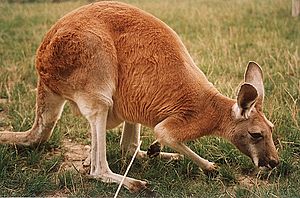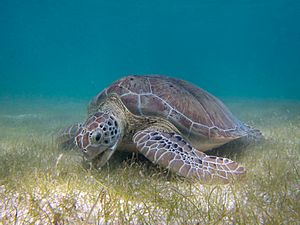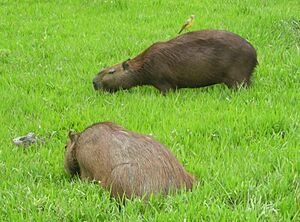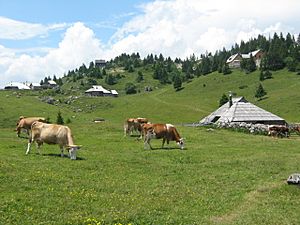Grazing (behaviour) facts for kids

Grazing is a special way some animals eat. It means they munch on low-growing plants like grasses or even tiny water plants called algae. Think of a Red kangaroo nibbling grass in a field, or a small Snail scraping algae off a rock! Many different animals, from huge hippos to tiny snails, are grazers. This feeding style is a key part of how animals live and interact with their environment.
Contents
What is Grazing?
Grazing is when an animal eats plants that grow close to the ground. This is different from "browsing," which is when animals eat leaves and twigs from taller trees and shrubs. When an animal grazes, it usually doesn't kill the plant, unlike a predator that hunts and kills its prey. It's also not like parasitism, where one organism lives on or inside another.
Some water animals are called grazers–scrapers. They use their mouths to scrape off algae and other tiny living things from stones and surfaces underwater.
Animals That Graze
Many animals have amazing ways to graze and get the nutrients they need.
Grass Eaters (Graminivores)
Animals that mostly eat grass are called graminivores. You might know some of them! Horses, cattle, capybara, hippopotamuses, grasshoppers, and geese are all graminivores. Even giant pandas are graminivores, as almost all their diet is bamboo, which is a type of grass!
Special Digestion: Cecotrophy
Some animals, like rabbits, hares, and pikas, have a clever way to get all the goodness from tough plants. They eat their food, and some of it passes through their body as regular waste. But to get more nutrients from hard-to-digest fibers, they process it in a special part of their gut called the cecum. Then, they produce soft pellets called cecotropes, which they eat again! This second pass helps them absorb all the important vitamins and minerals.
Capybaras, the world's largest rodents, also do this. They mainly graze on grasses and water plants. They can be picky eaters, choosing specific plants. Like rabbits, capybaras eat their cecotropes to get extra nutrition. Their front teeth grow constantly because of all the chewing they do!
Hippos: Unique Grazers
Hippos are huge, semi-aquatic mammals. During the day, they stay cool in water or mud. But at night, they come out to graze on grasses. Even though they rest together, they usually graze alone. Hippos don't use their long incisors or canines for eating; those are for fighting! Instead, they use their wide, strong lips to grab grass, which they then grind with their molars. Hippos have a special stomach with three or four chambers, but they don't chew their cud like cows do.
Grazing Beyond Grass
Grazing isn't just about mammals eating grass. Ecologists use the term more broadly. For example, marine biologists call sea urchins that eat kelp "grazers." Even tiny aquatic snails that feed on the thin layer of algae and other tiny bits covering underwater surfaces are considered grazers. In coral reefs, small crustaceans that graze help keep the habitat healthy by stopping too much algae from growing.
Why Grazing is Important
Grazing plays a big role in keeping our planet healthy.
Helping the Environment
When grazers eat plants, their urine and feces return important nutrients like nitrogen, phosphorus, and potassium to the soil. This is like natural recycling! Grazing also helps build up organic matter in the soil, which can prevent soil erosion. This organic matter feeds tiny insects and other organisms in the soil, which helps store carbon and filter water.
Boosting Biodiversity
Grazing can make an area more diverse with different kinds of plants. When animals graze, they reduce the amount of dead grass. This is good for birds like waterfowl. Without grazing, often only a few types of grasses, like brome and bluegrass, would grow, creating a "monoculture" (meaning only one type of plant).
In places like North American tallgrass prairies, grazing by large animals like bison works with natural fires to keep the ecosystem balanced. Spring fires help certain grasses grow, and bison prefer to eat those grasses. This natural cycle allows many different plant species to thrive.




